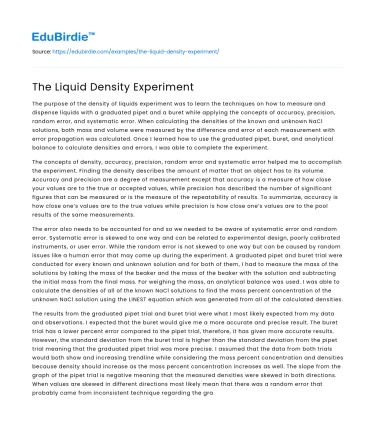The purpose of the density of liquids experiment was to learn the techniques on how to measure and dispense liquids with a graduated pipet and a buret while applying the concepts of accuracy, precision, random error, and systematic error. When calculating the densities of the known and unknown NaCl solutions, both mass and volume were measured by the difference and error of each measurement with error propagation was calculated. Once I learned how to use the graduated pipet, buret, and analytical balance to calculate densities and errors, I was able to complete the experiment.
The concepts of density, accuracy, precision, random error and systematic error helped me to accomplish the experiment. Finding the density describes the amount of matter that an object has to its volume. Accuracy and precision are a degree of measurement except that accuracy is a measure of how close your values are to the true or accepted values, while precision has described the number of significant figures that can be measured or is the measure of the repeatability of results. To summarize, accuracy is how close one’s values are to the true values while precision is how close one’s values are to the pool results of the same measurements.
Save your time!
We can take care of your essay
- Proper editing and formatting
- Free revision, title page, and bibliography
- Flexible prices and money-back guarantee
The error also needs to be accounted for and so we needed to be aware of systematic error and random error. Systematic error is skewed to one way and can be related to experimental design, poorly calibrated instruments, or user error. While the random error is not skewed to one way but can be caused by random issues like a human error that may come up during the experiment. A graduated pipet and buret trial were conducted for every known and unknown solution and for both of them, I had to measure the mass of the solutions by taking the mass of the beaker and the mass of the beaker with the solution and subtracting the initial mass from the final mass. For weighing the mass, an analytical balance was used. I was able to calculate the densities of all of the known NaCl solutions to find the mass percent concentration of the unknown NaCl solution using the LINEST equation which was generated from all of the calculated densities.
The results from the graduated pipet trial and buret trial were what I most likely expected from my data and observations. I expected that the buret would give me a more accurate and precise result. The buret trial has a lower percent error compared to the pipet trial, therefore, it has given more accurate results. However, the standard deviation from the buret trial is higher than the standard deviation from the pipet trial meaning that the graduated pipet trial was more precise. I assumed that the data from both trials would both show and increasing trendline while considering the mass percent concentration and densities because density should increase as the mass percent concentration increases as well. The slope from the graph of the pipet trial is negative meaning that the measured densities were skewed in both directions. When values are skewed in different directions most likely mean that there was a random error that probably came from inconsistent technique regarding the graduated pipet that was used to measure the solutions. On the other hand, the slope from the graph of the buret trial is positive and increasing which shows that the values were consistent but since the results were skewed in one direction, there could have been some systematic error because there was still some percent error in the buret trial. A systematic error like having too little or too much volume of the liquid could be a factor as to why the values may have not been consistent. When doing measurements, the human eye can perceive things differently and therefore causing the results to not be exactly accurate or precise. The relationship between the solute concentration and solution density is that the more concentration the solution is then the higher density should because mass should also be slowly increasing.
Did you like this example?
Make sure you submit a unique essay
Our writers will provide you with an essay sample written from scratch: any topic, any deadline, any instructions.
Cite this paper
-
APA
-
MLA
-
Harvard
-
Vancouver
The Liquid Density Experiment.
(2022, August 25). Edubirdie. Retrieved April 18, 2025, from https://hub.edubirdie.com/examples/the-liquid-density-experiment/
“The Liquid Density Experiment.” Edubirdie, 25 Aug. 2022, hub.edubirdie.com/examples/the-liquid-density-experiment/
The Liquid Density Experiment. [online].
Available at: <https://hub.edubirdie.com/examples/the-liquid-density-experiment/> [Accessed 18 Apr. 2025].
The Liquid Density Experiment [Internet]. Edubirdie.
2022 Aug 25 [cited 2025 Apr 18].
Available from: https://hub.edubirdie.com/examples/the-liquid-density-experiment/
copy






 Stuck on your essay?
Stuck on your essay?

